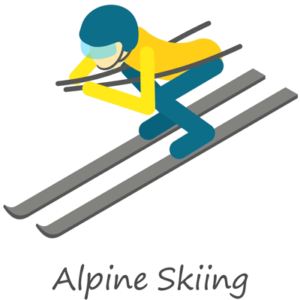 Sometimes referred to as downhill skiing, the art of alpine skiing involves getting down snow covered slopes using skis that have fixed-heel bindings. The difference is important when you realise that other skiing disciplines like ski jumping and cross-country skiing use free-heel bindings.
Sometimes referred to as downhill skiing, the art of alpine skiing involves getting down snow covered slopes using skis that have fixed-heel bindings. The difference is important when you realise that other skiing disciplines like ski jumping and cross-country skiing use free-heel bindings.
That’s not the only thing that differentiates the activity from other forms of skiing, of course. It’s not unusual for skiers to go ‘off-piste’, for example, sometimes using snowmobiles or even helicopters to get them to the top of an otherwise difficult to reach slope.
The more simplistic version of the pastime takes place at ski resorts where there are ski lifts to take participants to their destination. There are also restaurants on resort and sometimes artificial snow is used to ensure that the slopes are ready for use in the key seasons.
In essence there is actually very little difference between the version of the event that an average punter can take part in and the one that is done by professionals, with the level of difficult of the slopes being the number one deciding factor. It is the competitive version of things that we’re most interested in, with alpine skiing having been part of the Winter Olympics since 1936.
Best Site For Alpine Skiing Bets
Bet365

Bet365 is the place to go for all types of skiing bets, they have the most advance outright lines on the men and women's World Cup, winter Olympics and World Ski Championships.
Prices themselves are also highly competitive, which is a huge advantage considering not that many bookies provide markets for skiing.
Any of the big bookies are good options for these sports, especially closer to events it is the brands with the biggest resources and most traders that have good market depth and plenty of all sports offers that can be used for betting on skiing
Betting On Alpine & Downhill Skiing
| Market | Details |
|---|---|
| Podium Finish | Do you think you know which skiers will end the event on the podium? This is the bet for you, being similar to the Place bet in horse racing. You’ll get paid if your selected participant finishes in the top 3 |
| Outright Winner | Whether betting ante-post or once the event is underway, this bet will only payout if your selected skier wins the event. You can usually bet on every entrant due to participate in the event, so make sure you do your research |
| Match Betting | Sometimes referred to as ‘Matchup Betting’, this asks you which out of two competitors will do better than the other in a given event. How they do overall is irrelevant for this type of bet |
Betting on skiing can be a bit of a crapshoot if you don’t know what you’re looking out for. A lot of the biggest betting sites don’t really offer much more than a passing interest in skiing, meaning that you’ll need to a little bit more specialist in your bookmaker selection if you’re hoping to place specific bet types.
If, on the other hand, you’re happy enough betting on quite generic events then you’ll be fine. Here are some of the major markets you can look out for:
The History Of Alpine Skiing
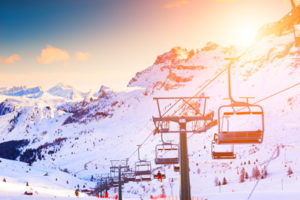 Digs in the likes of Sweden, Finland, Norway and Russia have found evidence of various wooden planks that were believed to have been used to move people from one location to another. Those primitive types of ski were found in bogs, with the more modern version tracing its history back to when they were used to get people across marches and wetlands when they froze over in the winter and people needed to be able to move on them.
Digs in the likes of Sweden, Finland, Norway and Russia have found evidence of various wooden planks that were believed to have been used to move people from one location to another. Those primitive types of ski were found in bogs, with the more modern version tracing its history back to when they were used to get people across marches and wetlands when they froze over in the winter and people needed to be able to move on them.
By the 1760s the art of skiing was included in military training, with the Norwegian army in particular prone to asking its soldiers to ski down slopes, around trees and even to try to shoot obstacles whilst skiing.
The modern day sport can trace its own origins to the 1850s, which was the point at which it began to shift from being nothing more than a method of transportation into a more competitive and recreational pastime. The Norwegian Sondre Norheim is widely believed to be the man responsible for modernising the skis themselves, adding a curved side and bindings as well as creating the slalom turn.
He was also the first downhill skiing competition champion, which took place in Oslo in 1868. Within three decades the sport had spread to the rest of Europe and the United States, though a slalom skiing competition didn’t occur until 1922 when the Swiss village of Mürren hosted one.
The Timeline Of Skiing

Skiing as a sport has enjoyed some seminal moments that helped to shape it into the event that it is today. Here’s a look at some of those crucial times through the years when something has happened to develop skiing to become one of the most important sports in the Winter Olympics:
- 1843: The first public skiing competition takes place in Norway
- 1861: The first ski clubs are formed
- 1862: Ski jumping competition open to the public is held
- 1879: The word ‘slalom’ is used for the first time in recorded history
- 1884: Trondheim hosts the first cross-country skiing competition
- 1905: The U.S. Ski and Snowboard Association is formed
- 1922: Competitive slalom skiing created by Arnold Lunn
- 1924: The International Ski Federation is formed in the same year that the Winter Olympics take place for the first time
- 1936: Winter Olympics include downhill skiing for the first time
- 1976: Paralympic cross-country skiing is included in the Paralympics
- 2014: Women’s ski jumping included in the Winter Olympics for the first time
Skiing Joins The Olympic Roster
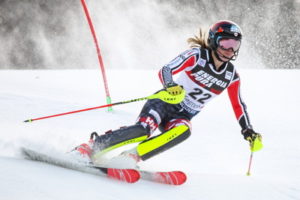 Unquestionably the key moment for skiing as a sport came in 1936 when the alpine discipline for both men and women was added to the Olympic roster for the first time. The Olympics allowed it in as a combined event that saw an amalgamation of both downhill and slalom skiing, rather than looking at them as two separate disciplines as the competition does today.
Unquestionably the key moment for skiing as a sport came in 1936 when the alpine discipline for both men and women was added to the Olympic roster for the first time. The Olympics allowed it in as a combined event that saw an amalgamation of both downhill and slalom skiing, rather than looking at them as two separate disciplines as the competition does today.
Indeed, by 1948 a decision had been taken to maintain the original skiing event held in Garmisch-Partenkirchen twelve years earlier and add in both slalom and downhill skiing disciplines to mix things up. The combined discipline was removed in the 1940s but the giant slalom was added in 1952 and things then remained much the same for a number of decades.
In fact, it wasn’t until 1988 that the super giant slalom was added to the Olympic roster to become the fourth skiing event of the Winter Olympics, which was also the same year that the combined event returned, remaining until 1998 when it was dropped for the combined slalom and the combined downhill events.
The Fédération Internationale de Ski
 The Fédération Internationale de Ski, which translates as the International Ski Federation and is better known by the abbreviation FIS, was founded on the 18th of February 1910. It saw delegates from the top ten skiing countries in the world come together for the formation of an organisation that then bore the name ‘the International Skiing Commission in Christiania’. It changed its name in 1924 during the first ever Winter Olympic Games.
The Fédération Internationale de Ski, which translates as the International Ski Federation and is better known by the abbreviation FIS, was founded on the 18th of February 1910. It saw delegates from the top ten skiing countries in the world come together for the formation of an organisation that then bore the name ‘the International Skiing Commission in Christiania’. It changed its name in 1924 during the first ever Winter Olympic Games.
Since those days it has grown to become the governing body for the sport and is responsible for numerous Olympic disciplines. These include cross-country, freestyle and alpine skiing as well as snowboarding and ski jumping. By 2019 it boasted 131 member nations, operating out of its Swiss base in Oberhofen am Thunersee. As well as being the organising body for the Winter Olympics, FIS is also responsible for numerous different competitions including the FIS World Championships and the FIS Alpine World Ski Championship.
The Equipment
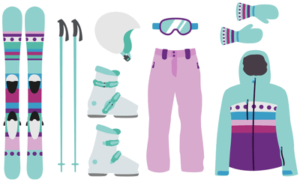 It goes without saying that the most important equipment involved in skiing are the skis themselves. They are improving every year, barely being recognisable compared to those used during the 1980s and offering numerous different types of skis depending on the event that the user is taking part in. If there is a huge amount of fresh snow on the slopes, for example, then powder skis are usually brought in for use, whilst a typical alpine skier would be more likely to use all-mountain skis.
It goes without saying that the most important equipment involved in skiing are the skis themselves. They are improving every year, barely being recognisable compared to those used during the 1980s and offering numerous different types of skis depending on the event that the user is taking part in. If there is a huge amount of fresh snow on the slopes, for example, then powder skis are usually brought in for use, whilst a typical alpine skier would be more likely to use all-mountain skis.
The ski also includes a binding, which is what links the skiers boots to the skis themselves and have a safety release to prevent an injury. There are two main types of binding: the heel and toe system and the plate system.
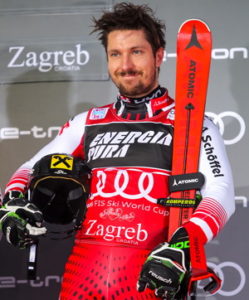 If skis are the most important piece of equipment then the boots aren’t too far behind, connect the user to the skis and giving them control over the skis themselves. The boots are split into two parts, which constitute the inner boot and the outer shell. The latter is made of plastic and is what clicks into the binding, also offering a buckle to allow users to make sure they’re attached to them securely.
If skis are the most important piece of equipment then the boots aren’t too far behind, connect the user to the skis and giving them control over the skis themselves. The boots are split into two parts, which constitute the inner boot and the outer shell. The latter is made of plastic and is what clicks into the binding, also offering a buckle to allow users to make sure they’re attached to them securely.
Poles are used to both help propel a skier along and also offer a degree of balance as the skier moves along a slope. They are important, but not as crucial as the helmet that offers protection for the user to avoid a head injury. They are usually made of hard plastic and have an inner liner that is designed to trap warmth inside.
They’re important because in 2014 there were over 114,000 alpine skiing injuries, with head injuries having the possibility of being life-threatening. In the world of alpine skiing between 2 and 4 people will need to see a medical professional per 1,000 skiers on average.
Major Competitions
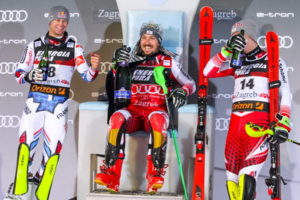 The world of competitive alpine skiing is broken up into two main disciplines: racing and freestyle skiing. The former includes the slalom, giant slalom and combined race types whilst the latter is more about events such as moguls, halfpipe and skicross. Neither speed skiing nor grass skiing are usually considering to be part of the alpine skiing discipline, though both come under the auspices of the FIS.
The world of competitive alpine skiing is broken up into two main disciplines: racing and freestyle skiing. The former includes the slalom, giant slalom and combined race types whilst the latter is more about events such as moguls, halfpipe and skicross. Neither speed skiing nor grass skiing are usually considering to be part of the alpine skiing discipline, though both come under the auspices of the FIS.
When it comes to competitive skiing there are also two things to think about, which are whether you’re looking at generic competitions that any skier can enter or whether you’re more concerned with top-class skiing competitions that are only open to those at the top of their game.
When it comes to the latter there are three main competitions that the best of the best take part in each time they roll around, so we’ll look at them closer here:
The FIS World Cup
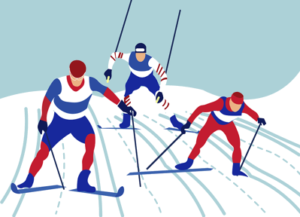 The FIS World Cup is an example of how a group of enthusiasts can influence the biggest movers and shakers in a given sport. It was started in 1966 by a group of friends who loved skiing. They were helped in their desire to make it a major event by the fact that some of those friends included a French journalist, the alpine ski directors of France and others from the USA, but the fact remains that they wanted to start a competition and they did so.
The FIS World Cup is an example of how a group of enthusiasts can influence the biggest movers and shakers in a given sport. It was started in 1966 by a group of friends who loved skiing. They were helped in their desire to make it a major event by the fact that some of those friends included a French journalist, the alpine ski directors of France and others from the USA, but the fact remains that they wanted to start a competition and they did so.
The President of the International Ski Federation, Marc Holder, soon offered it his backing and by the spring of the following year it had become an official FIS event. The event offers numerous disciplines for competitors to prove their worth in, namely:
- Slalom
- Giant Slalom
- Super G
- Downhill
- Combined
Points are given to the top finishers in each event and the skier with the most points in any given discipline is declared the winner. The points are awarded as follows:
- 1st: 100 points
- 2nd: 80 points
- 3rd: 60 points
Fewer and fewer points are then awarded to competitors until the skier that came 30th receives just 1 point.
This is an annual event and takes place across a season, requiring immense discipline from competitors and leading to it widely being perceived to be even more prestigious an event than the Olympics. It often takes place around the world and has been known to be hosted by countries as diverse as Argentina and Japan.
The FIS Alpine World Ski Championships
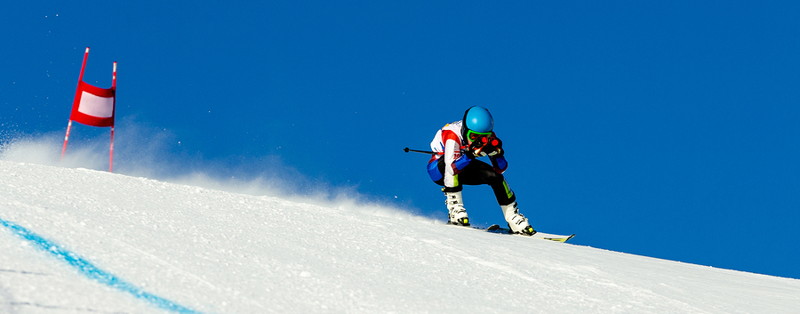
Often just referred to as the World Ski Championships, the event was held for the first time in 1931 meaning that it pre-dates the Winter Olympics. It was originally held annually until the outbreak of the Second World War and when they returned after the war’s conclusion the event was actually seen as an offshoot of the Olympics. The event was held outside of Europe for the first time when Aspen acted as the host in 1950.
Since 1985 the World Ski Championships have been held in odd-numbered years, with the exception coming in 1995 when there was a lack of snow that resulted in the event being pushed back to the following year. As with the World Cup, the World Ski Championships see men and women compete in the following disciplines:
- Combined
- Downhill
- Slalom
- Giant Slalom
- Super G
It also has a parallel event and a team event that is for mixed gender teams.
The Winter Olympics
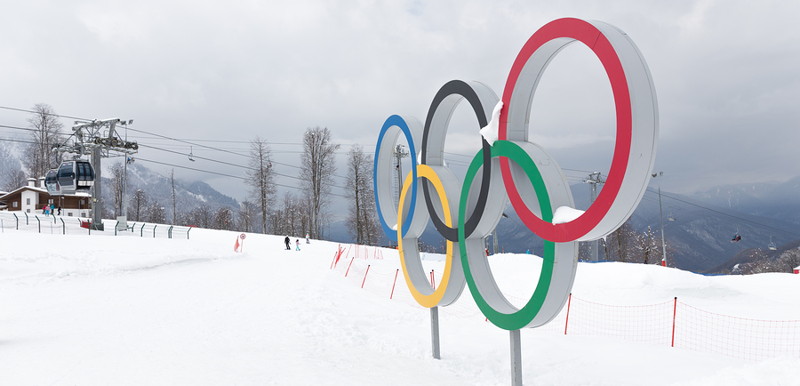 The combined event competed at the Winter Olympics in 1936 was the first time that skiing had taken place under the auspices of the Olympic Games. It uses the same disciplines and the other two major competitions, adding in an event for mixed gender teams in the same manner as the World Ski Championships.
The combined event competed at the Winter Olympics in 1936 was the first time that skiing had taken place under the auspices of the Olympic Games. It uses the same disciplines and the other two major competitions, adding in an event for mixed gender teams in the same manner as the World Ski Championships.
At the time of writing, Austria sit at the top of the all-time medal table, having collected nearly double the amount of medals that the next closest nation can offer.
The Disciplines
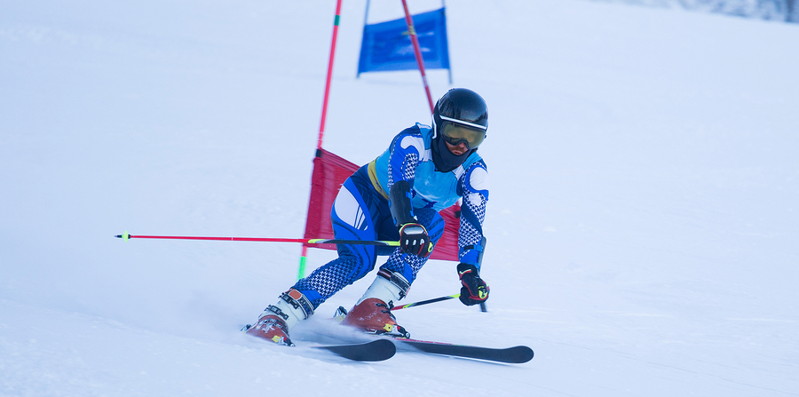
Here’s a quick explanation of the five major disciplines that take place in the various tournaments:
Downhill Skiing
This discipline looks specifically at the six components of skiing, which are speed, risk, judgement, technique, physical condition and courage. Courses are usually up to 30 metres wide with a number of vertical drops as well as ‘gates’, which consist of two poles with a panel between them.
Slalom Skiing
This discipline is all about the ability of skiers to twist and turn through a course that consists of poles or gates spaced closely to each other.
Giant Slaloming
This is similar to slalom skiing but the gates that the competitors need to ski through are spaced further apart. This is a technical event as opposed to the more speed-based nature of downhill skiing.
Super-G
Considered to be a speed event, Super-G asks skiers to pass through gates that are spaced widely apart from each other. Competitors only get one chance to clock up the fastest speed possible, hence the high speeds often reached.
Combined
This was the first ever type of skiing to take place at the Winter Olympics and asks competitors to take on one downhill course and two slalom courses. The disciplines are raced on different days and the skier with the fastest aggregate time is the winner.
There is another version of this known as the Super Combined, which adds a speed race in the form of either a downhill or Super-G to a slalom run. Both of those runs take place on the same day.
